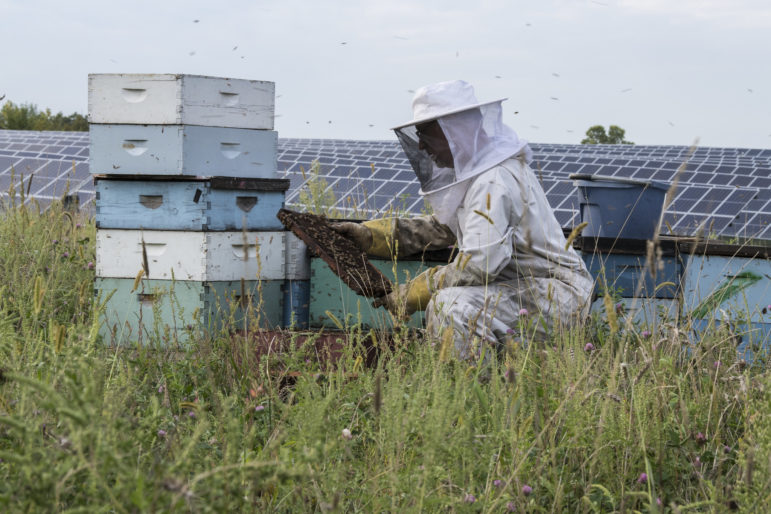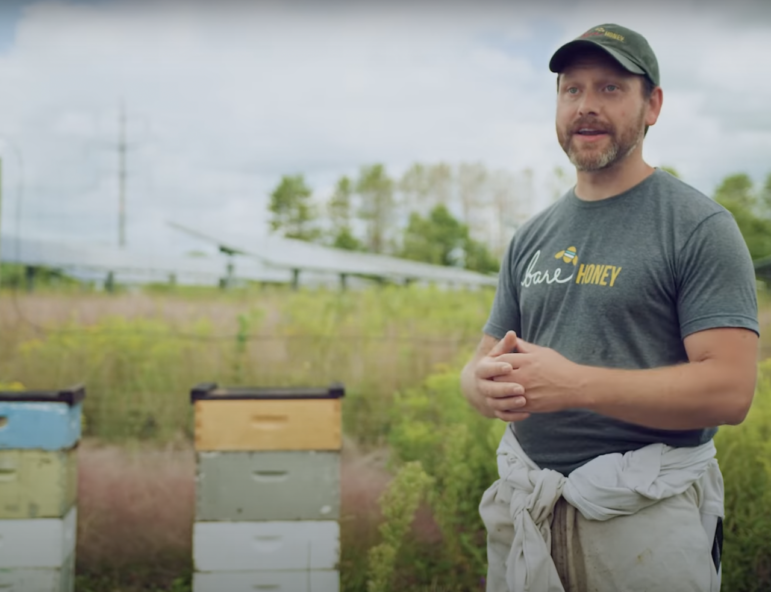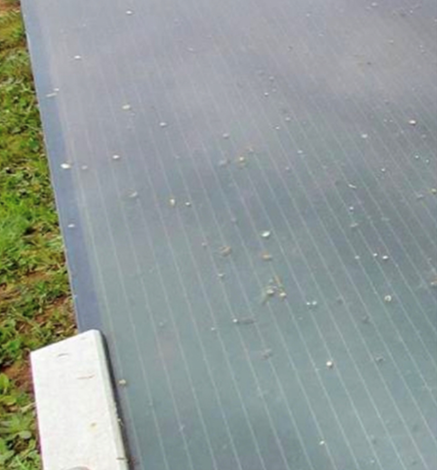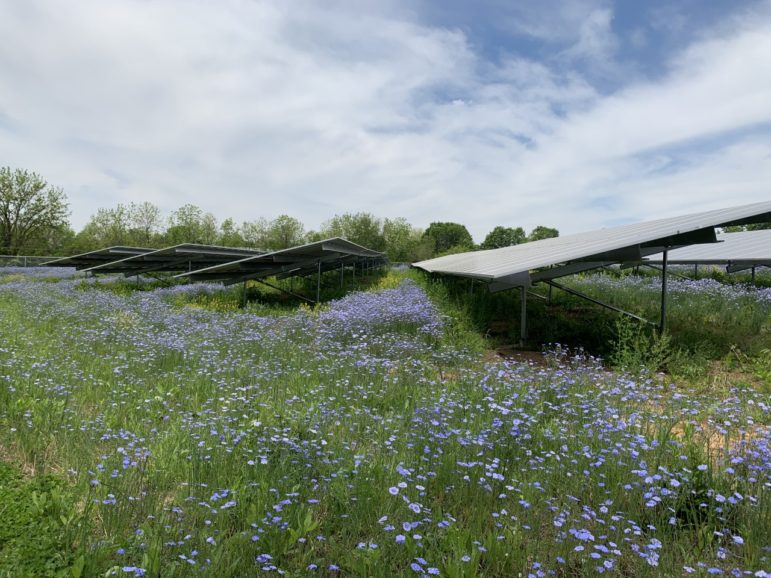
Each year, the United Nations and others observe May 20, the birthday of 18th century beekeeping pioneer Anton Janša, as World Bee Day, and several weeks later countries including the United States observe National Pollinator Week. But this year stands out for a particularly modern twist: Between World Bee Day and National Pollinator Week, this year a record number of regional and global energy companies highlighted the compatibility and ecological benefits of hosting honey bee hives or encouraging wild pollinators at their solar farms.
It is exciting to see all the advancements and innovations that enable photovoltaic (PV) solar farms to provide co-benefits and dual-uses. With large-scale solar farm growth accelerating globally, now is a good time for companies to review and implement a programmatic approach to ensure their sites deliver to both the climate and ecological emergencies, and society’s needs. Thanks to the education and outreach work of groups around the world—including the Center for Pollinators in Energy at Fresh Energy—global energy companies are actively moving forward with plans to combine solar farms with additional land uses to deliver ecological and community benefits. Particularly with regard to pollinators, dual-use solar farms are buzzing across the globe.
Co-locating gets its start
Around the same time solar started taking off in southwestern U.S. states, it was growing rapidly in England and Germany. While engineering and design principals vary location to location, what remains the same within many companies in a number of nations is the shared commitment and priority given to nurturing opportunities to enhance biodiversity and agricultural functions. Solar farms with flowering, low-growing meadows under and around the panels have become a common practice. But how did we get here?

The practice of co-locating solar farms and pollinators – both honey bee apiaries and wild pollinators, through managing sites as species-rich grasslands – occurs across the world. These practices found fertile ground among U.S. pollinator, solar, and agricultural advocates alike, many of whom came together to establish the nation’s first statewide standard for vegetation on solar farms. Managing solar farms for wild pollinators also delivers many other ecological benefits. For example, sites planted with mixtures of deep-rooted and flowering plants capture and filter storm water, create valuable habitats, build topsoil, and provide abundant and healthy food for beneficial insects that are crucial to our food systems.
By making meaningful, incremental changes to seed-mix design and vegetation management practices, pollinator-friendly solar development across the world benefits managed and native pollinating insects and other wildlife—and it’s catching the attention of big worldwide players like Enel, ENGIE, BayWa r.e. Global, Iberdrola, and EDF Renewables.
The Center for Pollinators at Fresh Energy has played a leading role in accelerating these dual-use solar practices. The ”World Changing Ideas” section of Fast Company ran a prominent feature story highlighting our pollinator-friendly solar work in 2018, when Fresh Energy’s Center for Pollinators in Energy helped connect Pine Gate Renewables with John Jacob of Old Sol Apiaries. Other industry media, like Solar Power World and Utility Dive, have highlighted the importance of PV solar farms using ground cover that provides enhanced ecosystem benefits and dual-uses.
“Sharing and not competing for land use with the primary sector is the best mechanism to achieve long-term sustainability for our solar plants.”
Inmaculada Fiteni, head of sustainability programs at Endesa, Spain’s largest multinational electric utility company
Pollinator best practices for solar farm operators
Mind the land. With 400,000 acres of signed contracts for solar projects to be built by the end of 2024 in the US, continued public support for pro-solar policies and subsidies depends on broad coalitions and demonstration of beneficial land stewardship. It’s not rocket science—start with this set of ten evidence-based recommendations published by Lancaster University. For example, establish low-growing perennial ground cover that includes plants that flower throughout the season. Remember that incremental changes to seed mixtures can make a meaningful difference. Depending on the soil and site, a solar array area can include low-grow clover and other species, with open areas banked with diverse communities of flowers, sedges, and grasses. In addition, reducing or avoiding agrochemical use, promoting landscape connectivity and providing climate niches are all beneficial for pollinators too.
Communicate clearly about biodiversity. Having a flock of chickens will not save the eagles, and having a few honey bee hives won’t “save the bees” or provide broad biodiversity benefits. Dr. Shiela Colla reminds us that “Livestock cannot replace native biodiversity.” Making bold claims without sound ecological understanding or evidence could cause the industry more harm than good, attracting accusations of greenwashing. Consequently, ensuring decisions are well grounded and impacts assessed is critical.
Place matters. Every site is different, with greater or lesser potential depending on the characteristics and the surrounding land. Consequently, implementing practices that are suitable for your site in light of climate, ecosystem, site history and current management, perhaps advised by a local ecologist, will deliver the best returns.
Beekeeping top tips for solar farm operators
As co-location of beekeeping and large-scale solar continues to spread across the globe and more and more companies adopt the practice, some important lessons to keep in mind are:

Remember that honey bees poop. Particularly in arid regions, it’s important to keep honey bee hives 20 feet (6 meters) or more from PV panels. Over time, honey bee droppings accumulate and are notoriously difficult to remove.
Safety first. Ensure placement of honey bee hives includes at least one or more empty bee boxes. As honey bee hives grow, it’s natural for a new queen to emerge and a portion of the hive to look for a new home—if a new home is available, they won’t go looking at inverter boxes or leave altogether. Additionally, make sure that the honey is cleaned through a food-safe, licensed, and insured facility—while the risk is incredibly low, nobody needs food-borne illness.
Pay your beekeeping partners. The only way to become a beekeeper is to be willing to be stung in the nose. Pay your beekeeper for professional hive placement and management, and guarantee purchase of a portion of all of the honey. Professional agreements, like this one from Pace University, and management help ensure honey bee hives remain disease-free and healthy.
Consider improving habitats for wild pollinators too. If you can design and manage the vegetation to provide incremental benefits for wild pollinators, this will return even more benefits, not least by providing additional food sources for the honey bees. It will boost pollination services and the biodiversity of the site more generally.
Solar apiaries in progress
Using pollinator-friendly ground cover has become too common to list all projects in existence. But, here are some noteworthy solar and beekeeping initiatives currently in operation around the world:

Enel (USA and Spain): In this video, Dustin Vanasse, founder of Bare Honey, shares how he’s working with Enel to produce local honey from pollinator habitats on the company’s 100 MW Aurora Solar farm in Minnesota (read the case study). Aurora’s pollinator-friendly, dual-use approach is helping generate energy with zero climate-harming emissions while providing a supportive habitat for bees. Enel also has ongoing solar/agriculture projects across Spain.
BayWa r.e. Global (Spain): BayWa r.e.’s 175 MW Don Rodrigo solar power plant is the first subsidy-free project of its kind in Europe. Noting how vegetation throughout the site reduces dust that makes the system less efficient, BayWa highlights how bees and solar energy create “the perfect harmony.”
Engie Green (France): Engie installed beehives at several of its solar PV parks in southern France’s Alpes-Côte d’Azur region. The company’s distributed solar group also has ongoing solar beekeeping projects in Minnesota and Vermont.
Iberdrola (Spain): Iberdrola installed beehives at its Andévalo PV plant in the Huelva province in southeastern Spain.
EDF Renewables (Canada): When EDF’s 23 MW Arnprior Solar Project came online in 2009, it more than doubled the grid-connected solar PV capacity in Canada. The project has also been home to honey bee hives.
Lightsource BP (UK): Before the publication was shuttered in 2020, Lightsource BP commissioned CNN’s “Great Big Story” to produce a video segment about solar and beekeeping.

GIANT Corporation, in partnership with EnterSolar/EDF: The GIANT Company has established a seven-acre, pollinator-friendly solar field at its corporate headquarters in Carlisle, Pennsylvania—the first project of its kind for a grocery retailer. The meadow that is part of the seven-acre solar field provides habitat for pollinators, birds, and other small wildlife while improving the quality of the soil beneath it, which reduces runoff.
And more: Low Carbon (UK); Eden Renewables (UK); Encore Renewables (Vermont & Maine); U.S. Solar (Minnesota); Impact Power Solutions (Minnesota).
Wherever their location, one thing is clear: solar apiaries are tools to be harnessed to increase the agricultural compatibility of PV solar farms. Solar sites planted with mixtures of deep-rooted and flowering plants capture and filter storm water, build topsoil, and provide abundant and healthy food for beneficial insects that are crucial to our food systems.
** This article was written for The Center for Pollinators in Energy at Fresh Energy, a national clearinghouse and catalyzer of pollinator-friendly solar information, standards, best practices, and state-based initiatives. The Center for Pollinators in Energy is a program of Fresh Energy, a clean energy nonprofit in Minnesota working to shape and drive bold policy solutions to achieve equitable carbon-natural economies. **
